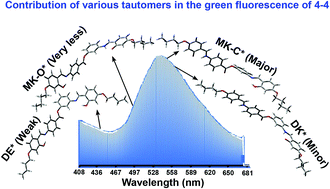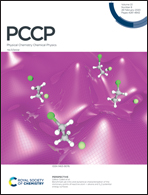Is the origin of green fluorescence in unsymmetrical four-ring bent-core liquid crystals single or double proton transfer?†
Abstract
The origin of green fluorescence in unsymmetrical four-ring bent-core liquid crystals (BCLCs) is not understood clearly. There is no analysis of the photo-physical properties, in particular, the excited state dynamical behaviour, of these molecules. Because of the availability of two proton transfer sites in these systems, there is no clear explanation of the involvement of single or double proton transfer reactions in the origin of the large Stokes shifted green fluorescence band. Therefore, we employ the femtosecond transient absorption spectroscopy technique to recognize the formation of transient species in the excited state and its associated dynamics in the femto-picosecond time domain. In order to validate the experimental photo-physical properties, the time-dependent density functional theory (TDDFT) calculations have been performed. Our results indicate that the four-ring bent-core system is an excellent example of systems exhibiting two proton transfer reactions in a sequential process. Further, these two proton transfer sites are not electronically coupled to each other; therefore, monoketo and diketo tautomers exhibit very close absorption and emission positions. The large Stokes shifted green emission in these systems is mainly contributed by the monoketo tautomer (MK-C*). The linking ester functional group of both sites plays a significant role in controlling the rate of proton transfer reactions. A good correlation is observed between theoretical and experimental results.



 Please wait while we load your content...
Please wait while we load your content...